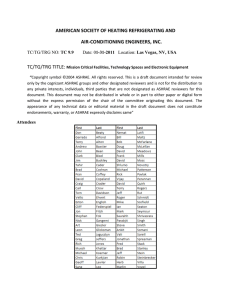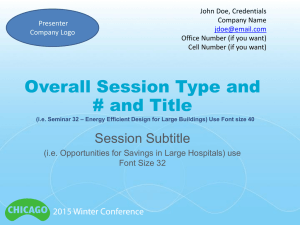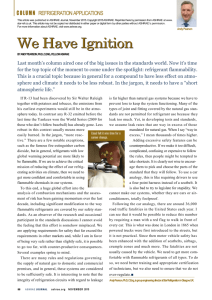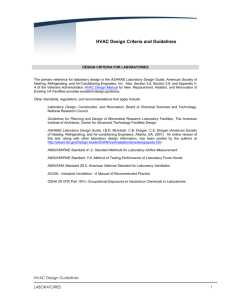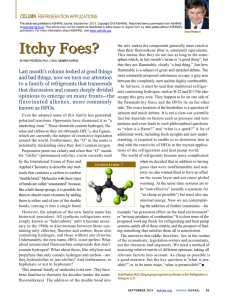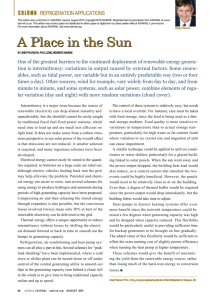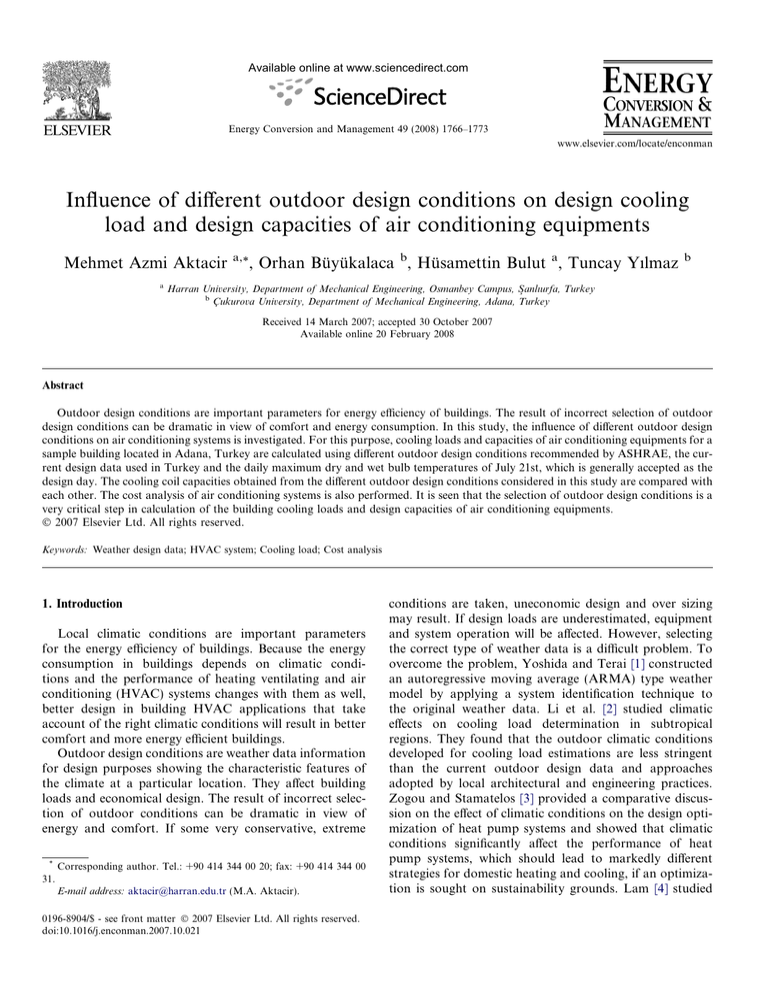
Available online at www.sciencedirect.com
Energy Conversion and Management 49 (2008) 1766–1773
www.elsevier.com/locate/enconman
Influence of different outdoor design conditions on design cooling
load and design capacities of air conditioning equipments
Mehmet Azmi Aktacir
a
a,*
, Orhan Büyükalaca b, Hüsamettin Bulut a, Tuncay Yılmaz
b
Harran University, Department of Mechanical Engineering, Osmanbey Campus, S
ß anlıurfa, Turkey
b
Çukurova University, Department of Mechanical Engineering, Adana, Turkey
Received 14 March 2007; accepted 30 October 2007
Available online 20 February 2008
Abstract
Outdoor design conditions are important parameters for energy efficiency of buildings. The result of incorrect selection of outdoor
design conditions can be dramatic in view of comfort and energy consumption. In this study, the influence of different outdoor design
conditions on air conditioning systems is investigated. For this purpose, cooling loads and capacities of air conditioning equipments for a
sample building located in Adana, Turkey are calculated using different outdoor design conditions recommended by ASHRAE, the current design data used in Turkey and the daily maximum dry and wet bulb temperatures of July 21st, which is generally accepted as the
design day. The cooling coil capacities obtained from the different outdoor design conditions considered in this study are compared with
each other. The cost analysis of air conditioning systems is also performed. It is seen that the selection of outdoor design conditions is a
very critical step in calculation of the building cooling loads and design capacities of air conditioning equipments.
Ó 2007 Elsevier Ltd. All rights reserved.
Keywords: Weather design data; HVAC system; Cooling load; Cost analysis
1. Introduction
Local climatic conditions are important parameters
for the energy efficiency of buildings. Because the energy
consumption in buildings depends on climatic conditions and the performance of heating ventilating and air
conditioning (HVAC) systems changes with them as well,
better design in building HVAC applications that take
account of the right climatic conditions will result in better
comfort and more energy efficient buildings.
Outdoor design conditions are weather data information
for design purposes showing the characteristic features of
the climate at a particular location. They affect building
loads and economical design. The result of incorrect selection of outdoor conditions can be dramatic in view of
energy and comfort. If some very conservative, extreme
*
Corresponding author. Tel.: +90 414 344 00 20; fax: +90 414 344 00
31.
E-mail address: aktacir@harran.edu.tr (M.A. Aktacir).
0196-8904/$ - see front matter Ó 2007 Elsevier Ltd. All rights reserved.
doi:10.1016/j.enconman.2007.10.021
conditions are taken, uneconomic design and over sizing
may result. If design loads are underestimated, equipment
and system operation will be affected. However, selecting
the correct type of weather data is a difficult problem. To
overcome the problem, Yoshida and Terai [1] constructed
an autoregressive moving average (ARMA) type weather
model by applying a system identification technique to
the original weather data. Li et al. [2] studied climatic
effects on cooling load determination in subtropical
regions. They found that the outdoor climatic conditions
developed for cooling load estimations are less stringent
than the current outdoor design data and approaches
adopted by local architectural and engineering practices.
Zogou and Stamatelos [3] provided a comparative discussion on the effect of climatic conditions on the design optimization of heat pump systems and showed that climatic
conditions significantly affect the performance of heat
pump systems, which should lead to markedly different
strategies for domestic heating and cooling, if an optimization is sought on sustainability grounds. Lam [4] studied
M.A. Aktacir et al. / Energy Conversion and Management 49 (2008) 1766–1773
climatic influences on the energy performance of air conditioned buildings and found that the predictions of annual
cooling loads, peak cooling loads and annual electricity
consumption differ by up to about 14%. Bulut et al. [5,6]
determined new cooling and heating design data for Turkey. They used the current outdoor design data locally used
and the new data presented in their studies [5,6] in order to
evaluate the influence of the weather data set on the heating and cooling load. They found up to 25% and 32% differences between the cases considered for cooling and
heating loads, respectively.
Outdoor design conditions corresponding to different
frequency levels of probability for several locations in the
United States and around the world are developed by the
American Society of Heating, Refrigeration and Air Conditioning Engineers, Inc. (ASHRAE) [7]. Weather data
includes design values of dry bulb temperature with mean
coincident wet bulb temperature, design wet bulb temperature with mean coincident dry bulb temperature and design
dew point temperature with mean coincident dry bulb temperature and corresponding humidity ratio. These design
data are the outdoor conditions that are exceeded during
a specified percentage of time. Warm season temperature
and humidity conditions correspond to annual percentile
values of 0.4, 1.0 and 2.0. Cold-season conditions are based
on annual percentiles of 99.6 and 99.0. The 0.4%, 1.0% and
2.0% annual values of occurrence represent the value that
occurs or is exceeded for a total of 35 h, 88 h and 175 h,
respectively, on average, every year, over the period of
record. The selection of frequency as risk level in design
conditions depends on the applications. Representing the
climatic design data for several frequencies of occurrence
will also enable designers to consider various operational
peak conditions.
1767
The main goal of this study is to investigate the influence
of the outdoor design conditions selected during sizing of
on air conditioning system. The analysis consists of three
main steps. In the first step, the total cooling loads of a
sample building are calculated utilizing different outdoor
design conditions such as the data given by ASHRAE [7]
and the current design data used by project engineers in
Turkey [8]. In the second step, design capacities of the all
air central air conditioning equipments selected for the
sample building are determined for the various outdoor
design conditions considered in the study. Finally, cost
analysis of the air conditioning system is performed for
the cooling season.
2. Description of the sample building
A high school building was selected in order to conduct
the analysis. The sample building is located in Adana, Turkey (36°59 0 latitude, 35°18 0 longitude and 20 m altitude).
Adana, an agricultural and industrial centre and the
nation’s fifth largest city, is near the Mediterranean Sea.
It is hot and humid in the cooling season. The sample
building has three almost identical floors. Fig. 1 shows
the architectural plan of the first floor. The gross area of
the building is 1628 m2, and the outside surfaces of the
walls are light colored. The long sides of the building face
north and south. The sample building is used as a high
school and is occupied between 08:00 and 17:00 h. The high
school has 224 students, 15 teachers, 4 officers and 3 laborers. The building has 14 classrooms, 3 laboratories, 5 offices, 1 library, 1 computer room and 3 corridors. The
building complies with the insulation requirement imposed
by Turkish Standard-TS 825, ‘‘Thermal Insulation in
Fig. 1. Architectural plan of the sample building.
1768
M.A. Aktacir et al. / Energy Conversion and Management 49 (2008) 1766–1773
Buildings’’ [9]. Table 1 shows the overall heat transfer coefficients of the high school envelope.
peratures, which are given by ASHRAE [7] at the 0.4%, 1%
and 2% frequency levels (ASHRAE_MAX_04, ASHRAE_MAX_1, ASHRAE_MAX_2), respectively. The last
data set is the daily maximum dry and wet bulb temperatures of July 21st (DAILY MAX) as design day data, which
are calculated from the meteorological data obtained from
the Turkish State Meteorological Service (Turkish initials
_
‘DMI’).
3. Outdoor design conditions
4. Air conditioning system
In the analysis, the various outdoor design condition data
sets of Adana were used. Details of the data sets are given in
Table 2. As shown in the table; there are five data sets. The
first data set is the current outdoor design conditions (CURRENT) [8] used by project engineers in Turkey. The second
and third data sets are outdoor design conditions for cooling
(ASHRAE_04, ASHRAE_1, ASHRAE_2) and evaporation systems recommended by ASHRAE [7] at the 0.4%,
1% and 2% frequency levels (ASHRAE_EVAP_04, ASHRAE_EVAP_1, ASHRAE_EVAP_2), respectively. The
fourth data set is the maximum dry bulb and wet bulb tem-
The sample building is conditioned by an all air conditioning system with constant air volume (CAV). The system
commonly consists of an air handling unit (AHU), air cooled
chiller system, supply and return fans, duct and control
units. Fig. 2 is a schematic of an all air central air conditioning system showing typical operating conditions. The
returned room air (state R) is mixed with the required outdoor air (state O) at the air handling unit. The mixed air
(state M) passes through the cooling coil. The outdoor air
is usually warmer and more humid than the return air under
typical operation conditions. Therefore, the cooling process
Table 1
Overall heat transfer coefficients (U) of the sample building envelope
2
U (W/m K)
Wall
Roof
Floor
Window
0.783
0.508
0.757
2.8
Table 2
Various outdoor design conditions for Adana, Turkey
No.
Description of the data set
Name of the data set
Risk level (%)
DB (°C)
WB (°C)
1
2
Current design (DBmax-WBmax)
ASHRAE-cooling (DB-CWB)
3
ASHRAE-evaporation (WB-CDB)
4
ASHRAE-max (DBmax-WBmax)
5
Daily-max (DBmax-WBmax)
CURRENT
ASHRAE_04
ASHRAE_1
ASHRAE_2
ASHRAE_EVAP_04
ASHRAE_EVAP_1
ASHRAE_EVAP_2
ASHRAE_MAX_04
ASHRAE_MAX_1
ASHRAE_MAX_2
DAILY MAX
–
0.4
1
2
0.4
1
2
0.4
1
2
–
38.0
36.1
34.6
33.2
31.7
30.5
29.9
36.1
34.6
33.2
35.2
26.0
21.6
21.8
22.3
26.0
25.4
24.9
26.0
25.4
24.9
24.1
MIXING SECTION
O
EXHAUST
R
Return Air
Outdoor Air
R
E
M
Mixing Air
RETURN FAN
COOLING UNIT
Qcoil
Qcooling
SPACE
S
S
SUPPLY FAN
Fig. 2. Schematic of air movement of an all air conditioning system.
O-Outdoor air
C-Apparatus dew point
R-Indoor air
M-Mixed air
S-Supply air
S
C
O
M
R
Sensible Heat
Ratio Line
Absolute Humidity [kg/kg dry air]
M.A. Aktacir et al. / Energy Conversion and Management 49 (2008) 1766–1773
Dry Bulb Temperature [˚C]
Fig. 3. State points of air during processing for summer operation of air
conditioning system on psychometric chart.
generally involves both cooling and dehumidification, with
the conditioned air leaving the cooling coil at state (S). The
cooled and dehumidified air leaving the coil at state (S) is
then supplied to the conditioned space at constant air volume, which is at state (R), to complete the cycle. Fig. 3 shows
the state points of air during the process for summer operation of the air conditioning system on a psychometric chart.
5. Calculation of cooling load
To design and select elements of a HVAC system, it is
very important to determine the heating and cooling loads
of the building. Weather data are very important to compute the loads accurately. However, selection of the most
1769
appropriate weather data set can be a difficult problem.
Conventional load calculation methods are divided into
two classes, i.e. peak load estimation and annual load simulation. Diurnally periodic weather data are used for peak
load estimation, but the correlation of weather elements,
i.e. temperature, solar radiation, moisture contents, etc.
can hardly be taken into account. Reference year weather
data are used for annual load simulation, but the results
can only give the seasonal summed load, no information
being obtained for the detailed load variations owing to
the shortness of the data period [1].
The total cooling load of a building consists of the external loads through the building envelope and internal loads
from people, lights, appliances and other heat sources. To
design and select a properly sized HVAC system, the peak
or maximum load for each zone must be computed for a
design day based on the required indoor and prevailing
outdoor design conditions.
In this study, the indoor design conditions of the building were chosen as 50% relative humidity and 26 °C dry
bulb temperature. The radiant time series method (RTS)
was used for calculation of the cooling load. The RTS
method, introduced by Spitler et al. [10] and the 2001 ASHRAE Handbook, Fundamentals [7], is a new simplified
means for performing design cooling load calculations,
and it was derived from the ‘‘heat balance method’’.
The total and the components of the cooling load and sensible heat ratio (SHR) of the sample building calculated
using the current outdoor design data (Table 2) are given
in Table 3 for different hours of the day. It can be seen from
the table that the maximum total cooling load of the building
Table 3
Cooling loads and SHR for CURRENT data set
Time
01:00
02:00
03:00
04:00
05:00
06:00
07:00
08:00
09:00
10:00
11:00
12:00
13:00
14:00
15:00
16:00
17:00
18:00
19:00
20:00
21:00
22:00
23:00
24:00
Parts of the cooling load (W)
Total cooling load (W)
SHR
External surface
Fenestration
Internal source
Sensible
Latent
Total
7603
6488
5496
4600
3805
3156
3177
4498
6888
9836
12,926
15,850
18,383
20,349
21,693
22,325
22,132
21,098
19,212
16,718
14,210
12,095
10,365
8882
7356
6379
5415
4643
5148
15,469
21,635
26,535
32,806
39,660
45,601
49,601
50,906
49,099
44,505
39,252
35,331
28,935
20,204
16,400
13,704
11,658
9943
7644
4193
3885
3577
3299
3020
3020
2712
46,056
50,675
53,446
55,293
56,525
57,449
58,064
58,710
56,028
56,173
15,861
11,815
9192
7432
6260
5366
5107
19,151
16,753
14,487
12,541
11,973
21,645
27,524
62,354
75,634
88,208
99,086
107,241
112,003
112,778
110,173
102,871
98,902
65,894
51,231
42,309
35,347
30,013
25,674
20,285
0
0
0
0
0
0
0
14,735
14,735
14,735
14,735
14,735
14,735
14,735
14,735
14,735
14,735
0
0
0
0
0
0
0
19,151
16,753
14,487
12,541
11,973
21,645
27,524
77,089
90,368
102,942
113,820
12,1976
126,738
127,513
124,907
117,605
113,636
65,894
51,231
42,309
35,347
30,013
25,674
20,285
1.00
1.00
1.00
1.00
1.00
1.00
1.00
0.81
0.84
0.86
0.87
0.88
0.88
0.88
0.88
0.87
0.87
1.00
1.00
1.00
1.00
1.00
1.00
1.00
M.A. Aktacir et al. / Energy Conversion and Management 49 (2008) 1766–1773
(127.51 kW) occurs at 14:00. While 39% of the total cooling
load is due to windows, 16% stems from the external surfaces
and the remaining portion is from internal heat sources.
Hourly cooling loads of the sample building were also
calculated using different outdoor design data sets
(Fig. 4). It can be seen from the figure that the cooling load
is affected considerably by the selected weather data set,
although the trends are the same. The maximum cooling
load is obtained with the data set of CURRENT. It was
followed by the data sets recommended by ASHRAE for
cooling and evaporation systems, respectively. The DAILY
MAX and ASHRAE_1 data sets produce almost the same
results.
The maximum design cooling loads and sensible heat
ratios (SHR) calculated for all the outdoor design conditions considered are given in Table 4. As can be seen from
the table, the maximum design cooling load (127.51 kW) is
obtained with the CURRENT data set. Table 4 also shows
the ratio of the design cooling load to the design cooling
load obtained from the CURRENT data set. The design
cooling load with ASHRAE_04, ASHRAE_1, ASHRAE_2, ASHRAE_EVAP_04, ASHRAE_EVAP_1 and
ASHRAE_EVAP_2 is 2%, 4%, 7%, 9%, 11% and 12% less
than the load with the CURRENT data set, respectively. In
the case of the DAILY MAX data set, the design load is
found to be 4% less than that for the CURRENT data
130000
Design Cooling Load (W)
120000
110000
100000
CURRENT
ASHRAE_04
DAILY MAX
ASHRAE_1
ASHRAE_2
ASHRAE_EVAP_04
ASHRAE_EVAP_1
ASHRAE_EVAP_2
90000
80000
70000
60000
8
9
10
11
12
13
14
15
16
17
Hour
Fig. 4. Total design cooling load for all design data sets.
Table 4
Total design cooling load, SHR and cooling load ratio for different data
sets
Data set
Qroom (kW)
SHR
Cooling load ratio
CURRENT
ASHRAE_04
ASHRAE_1
ASHRAE_2
ASHRAE_EVAP_04
ASHRAE_EVAP_1
ASHRAE_EVAP_2
ASHRAE_MAX_04
ASHRAE_MAX_1
ASHRAE_MAX_2
DAILY MAX
127.51
124.95
121.98
119.20
116.23
113.85
112.66
124.95
121.98
119.20
122.51
0.88
0.88
0.88
0.88
0.87
0.87
0.87
0.88
0.88
0.88
0.88
1.00
0.98
0.96
0.93
0.91
0.89
0.88
0.98
0.96
0.93
0.96
0.60
Weather Dependent Loads Ratio
1770
0.50
0.40
0.30
ASHRAE_04
0.20
ASHRAE_1
ASHRAE_2
0.10
8
9
10
11
12
13
14
15
16
17
Hour
Fig. 5. Ratio of weather dependent loads to the total cooling load for
ASHRAE data sets.
set. SHR is almost independent of the data sets used, and
it is about 0.88 for all the sets (Table 4).
The variation of the ratio of the weather dependent
component of the total cooling load to the total cooling
load during the occupation period is shown in Fig. 5. As
can be seen from the figure, the weather dependent components constitute approximately 50% of the total load.
6. Calculation of design capacities of air conditioning
equipments using different outdoor design conditions
The maximum (design) cooling coil capacity (Qcoil,max)
and the maximum (design) supply air flow rate (Mtot) for
the sample building were calculated using the maximum
building cooling load (Qroom) and sensible heat ratio
(SHR) given above, the minimum fresh air ventilation
requirement (Mout), the indoor and outdoor design conditions and the fixed supply air temperature as input parameters. Because of an iterative approach requirement in the
calculation procedure, a computer program was written
[11] for the calculations.
In the calculations, the temperature of the air supplied
to the air conditioned space was selected to be 16 °C.
According to the ASHRAE Standard 62 [12] ventilation
rate procedure, the minimum fresh air ventilation requirement for the sample building (Mout) was determined to be
7000 m3/h.
Table 5 gives the design cooling coil capacity (Qcoil,max),
total and fresh air mass flow rates (Mtot and Mout) and mixing ratio (U = Mout/Mtot) for all the outdoor design conditions considered in this study. It is seen from the table that
the design cooling coil capacity (184.05 kW) and the total
mass flow rate (39525 kg/h) required are maximum with
CURRENT data set. Table 5 also presents the ratio of
the design coil capacity to the maximum design coil capacity, which is obtained with the CURRENT data set (coil
capacity ratio), and the ratio of the total mass flow rate
to the maximum total mass flow rate, which is again
obtained with the CURRENT data set (fan capacity ratio),
for all the outdoor design conditions considered. It can be
M.A. Aktacir et al. / Energy Conversion and Management 49 (2008) 1766–1773
1771
Table 5
Design cooling coil capacity and other properties for different data sets for supply air temperature of 16 °C
Name of the data set
Qcoil,max (kW)
Coil capacity ratio
Mtot (kg/h)
Fan capacity ratio
Mout (kg/h)
U (%)
CURRENT
ASHRAE_04
ASHRAE_1
ASHRAE_2
ASHRAE_EVAP_04
ASHRAE_EVAP_1
ASHRAE_EVAP_2
ASHRAE_MAX_04
ASHRAE_MAX_1
ASHRAE_MAX_2
DAILY MAX
184.05
145.9
145.2
146.1
176.5
168.9
163.1
183.9
175.7
168.9
164.7
1.00
0.79
0.79
0.79
0.96
0.92
0.89
0.99
0.95
0.92
0.89
39,525
38,720
37,798
36,938
35,615
34,886
34,521
38,720
37,798
36,938
37,964
1.00
0.98
0.96
0.93
0.90
0.88
0.87
0.98
0.96
0.93
0.96
7739
7863
7888
7909
7866
7903
7926
7777
7820
7858
7834
20.0
20.3
20.9
21.4
22.1
22.7
23.0
20.1
20.7
21.3
20.6
seen from Table 5 that the ASHRAE data sets (ASHRAE_04, ASHRAE_1 and ASHRAE_2) used for cooling
applications produce the minimum design cooling coil
capacities. For these data sets, the design cooling coil
capacities are approximately 21% less than that of the
CURRENT data set. In the case of the DAILY MAX data
set, which is obtained from the daily maximum dry and wet
bulb temperatures of July 21, the design coil capacity is
11% lower than that obtained from the CURRENT data
set. It is noteworthy that one of the results given in Table
5 is that the design coil capacity obtained with the maximum dry bulb and wet bulb temperature selected from
ASHRAE design conditions for the 0.4 risk level (ASHRAE_MAX_04) is approximately equal to the design coil
capacity obtained for the CURRENT data set. This shows
that the current design conditions used in Turkey (CURRENT) were possibly derived from the maximum dry bulb
and wet bulb temperatures. In addition, when the data sets
are compared, considering maximum (design) supply air
flow rate (Mtot), the highest mass flow rate is again
obtained with the CURRENT data set. Therefore, it can
be concluded that the current outdoor design conditions
used in Turkey for design and selection of air conditioning
systems are generally stringent. The HVAC equipment
designs are oversized and consequently uneconomic. Both
the initial and operating costs of the air conditioning system increase because of over sizing the system.
7. Cost analysis of the air conditioning system
In this part of the study, the cost analysis of the all air
central air conditioning system is conducted for the CURRENT, ASHRAE_04, ASHRAE_1 and ASHRAE_2 data
sets. The results obtained for the CURRENT data set are
only compared with the ASHRAE_04, ASHRAE_1 and
ASHRAE_2 data sets due to their lower design cooling coil
capacity compared with those of the other data sets.
The air handling unit (AHU) and chiller system were
selected from the products of a local HVAC equipment
supplier. The AHU contains fans, cooling coil, filter, mixing and exhaust air elements. The total mass flow rate of
the AHU for all the data sets is 40,000 kg/h. The supply
and return fans in the AHU provide air and have 15 kW
and 12.5 kW power requirements, respectively. For the
air conditioning system, the mass flow rate is constant
throughout the operation of the system, therefore, even
for part load conditions, the fans require maximum power.
For the CURRENT design data set, the net cooling
capacity of the chiller system under nominal operating conditions (38 °C condenser air inlet temperature, 10 °C evaporator inlet and 6 °C outlet temperature) is 185 kW and the
power requirement of the unit is 80 kW. The compressor in
the chiller unit is controlled by a five stepped proportional
control system for part load operations.
It is clearly known that the compressor in the chiller unit
usually operates at part load under real operating conditions because of the varying cooling load. Whenever the
operating load is less than the design load, the capacity
of the compressor in the chiller unit should be reduced
by the five stepped proportional controller for saving
energy.
In cases of ASHRAE_04, ASHRAE_1 and ASHRAE_2, the net cooling capacity of the chiller system under
nominal operating conditions is 146 kW, and the power
required is 66 kW. The compressor in the chiller unit has
a four stepped proportional control for part load
operation.
The operating cost of the air conditioning systems consists of the electricity consumptions in the fans and the chiller unit. The cooling period for Adana covers 184 days
between April 15 and September 15. The daily operating
time of the central air conditioning system is 9 h (from
8:00 to 17:00). The electric price is 0.10 $/kW h.
In this study, the procedure given by Aktacir et al. [13] is
used to calculate the seasonal operating cost of the air conditioning systems. Firstly, the hourly cooling coil capacity
(Qcoil) for the 21st day of each month during the cooling
season was computed using the hourly cooling loads. Calculation of the hourly cooling loads requires hourly outside
air data. Hourly values of weather data were calculated
using a weather data model given by Bulut et al. [14].
The coil capacity for days other than the 21st day of
each month was not calculated. Therefore, the results
obtained for the 21st day of each month were integrated
1772
M.A. Aktacir et al. / Energy Conversion and Management 49 (2008) 1766–1773
on an hourly basis by the Simpson integral method and
seasonal average values of the hourly coil capacity (Qcoil,av)
were obtained.
Secondly, the variation of the coefficient of performance
(COP) of the chiller unit with outside air temperature and
the variation of COP with part load ratio were considered.
The part load ratio (PLR) was defined as
PLR ¼ Qchil =Qchil;full
ð1Þ
where Qchil is the hourly cooling demand on the chiller,
which is approximately equal to the hourly coil load (Qcoil),
and Qchil,full is the full cooling capacity of the chiller. The
automatic control system of the chiller unit will select a
suitable operating step for the compressor depending on
the value of PLR.
Using the data provided by the manufacturer and the
hourly outside air temperature, hourly values of cooling
capacity (Qchil) and power required (Pchil) of the chiller at
full load and at part load (for each of the five steps of
the chiller) were obtained for the 21st day of each month
during the cooling season. Seasonal average hourly values
of Qchil and Pchil (Qchil,av and Pchil,av) were then calculated
utilizing the Simpson integral method. Using the seasonal
average hourly values of coil load (Qchil,av) obtained previ-
ously and the chiller capacity at full load (Qchil,full,av) and
the seasonal average hourly part load ratio (PLRav), the
seasonal average hourly operating steps of the compressor
(STav) were determined.
Finally, from the corresponding part load Qchil,av,
Pchil,av and operating times, it was possible to calculate
the seasonal energy consumption and, then, the operating
cost of the chiller unit.
Tables 6 and 7 give the seasonal average operating cost
of the chiller and the fans selected for the data sets CURRENT and ASHRAE_04, ASHRAE_1 and ASHRAE_2,
respectively. The seasonal average hourly part load ratio
(PLRav), seasonal average hourly operating step (STav), seasonal average hourly power requirement (Pchil,av) and seasonal average hourly electric energy consumption are also
given in the tables. The compressor in the chiller unit usually operates at part load under real operating conditions
because of the varying cooling load. It can be seen from
Table 6 that the chiller system selected according to the
CURRENT data set operates 1 h at step 2 (25–50%), 4 h
at step 3 (50–75%) and 4 h at step 4 (75–100%). In the cases
of ASHRAE_04, ASHRAE_1 and ASHRAE_2 data sets,
(Table 7), the chiller system operates 1 h at step 2 (20–
40%), 4 h at step 3 (40–60%) and 5 h at step 4 (60–80%).
Table 6
Seasonal average operating cost of the selected chiller and fans for CURRENT data set
Device
Operating
time
Chiller
Fans
Part load ratio,
PLRav
Operating step,
STav
Power required,
Pchil,av (kW)
Electric consumption
(kW h/year)
Operating cost
($/year)
08:00–09:00
0.37
09:00–10:00
0.45
10:00–11:00
0.52
11:00–12:00
0.59
12:00–13:00
0.64
13:00–14:00
0.67
14:00–15:00
0.67
15:00–16:00
0.65
16:00–17:00
0.61
Total operating cost of the chiller ($/year)
2
3
3
3
4
4
4
4
4
24.58
37.00
38.12
39.13
54.49
55.34
55.81
55.65
54.83
4523
6808
7014
7200
10,026
10,183
10,269
10,240
10,089
452
681
701
720
1.003
1.018
1.027
1.024
1.009
7.635
08:00–17:00
1
Total operating cost of the fans ($/year)
–
27.5
45540
4.554
4.554
Table 7
Seasonal average operating cost of the selected chiller and fans for the data sets ASHRAE_04, ASHRAE_1 and ASHRAE_2
Device
Operating
Time
Chiller
08:00–09:00
0.45
09:00–10:00
0.55
10:00–11:00
0.65
11:00–12:00
0.72
12:00–13:00
0.78
13:00–14:00
0.82
14:00–15:00
0.83
15:00–16:00
0.80
16:00–17:00
0.75
Total operating cost of the chiller ($/year)
08:00–17:00
1
Total operating cost of the fans ($/year)
Fans
Part load ratio,
PLRav
Operating step,
STav
Power required,
Pchil,av (kW)
Electric consumption
(kW h/year)
Operating cost
($/year)
2
3
3
3
4
4
4
4
3
23.81
38.61
39.79
40.97
57.24
57.97
58.35
58.28
42.15
4381
7104
7322
7538
10,532
10,667
10,736
10,723
7755
–
27.5
45,540
438
710
732
754
1.053
1.067
1.074
1.072
775
7.676
4.554
4.554
M.A. Aktacir et al. / Energy Conversion and Management 49 (2008) 1766–1773
Table 8
Initial and yearly operating cost of the selected air conditioning system
Cost
Current
($)
ASHRAE for
all risk level ($)
Initial
Yearly total operating for proportional
control
Yearly total operating for on–off control
94.635
12.189
87.850
12.230
13.630
13.009
Consequently, the chiller system never operates at full load
during the whole cooling season.
The initial and total operating costs of the air conditioning system are presented in Table 8. When the system is
designed according to the ASHRAE data sets, the initial
cost is about 8% less than that when designed according
to the CURRENT data set. However, there is almost no
difference between the operating costs of the air conditioning system with proportional control for all the data sets
considered. This is due to the fact that the compressor in
the chiller unit of the air conditioning system is adjusted
by a stepped proportional control for part loads. However,
if a chiller unit with on–off type load control is selected
instead of the proportionally controlled one, the operating
cost for the ASHRAE data sets is approximately 5% less
than that for the CURRENT data set.
When the control systems are compared for the same
design data, it is seen that the operating costs of the on–
off control type are approximately 12% greater for the
CURRENT data set and 6% greater for the ASHRAE data
sets than that of the proportional control type. In the calculation of operating cost for the on–off control, it is
assumed that the maximum starting current is five times
higher than the nominal current.
8. Conclusion
In this study, the influence of different outdoor design
conditions on cooling loads and air conditioning system
is investigated. It is found that a significant part of the
cooling load depends on outdoor weather conditions. For
the sample building located in Adana, Turkey, approximately half of the cooling load originates from the building
envelope, which is weather dependent.
The findings indicate that the current outdoor design
conditions used in Turkey for design and selection of air
conditioning systems are generally stringent. The HVAC
equipments designed are oversized and consequently
uneconomic. Both the initial and operating costs of the
1773
air conditioning system increase because of over sizing
the system.
It seen that the control system of the chiller unit, which
is the main component of a HVAC system, is of great
importance for energy saving. Under real operating conditions, the HVAC system operates at part load. Therefore,
equipments that have a high efficiency at part loads should
be selected. Engineers and building designers should select
and assess the appropriate outdoor design conditions in
order to achieve optimum air conditioning equipment sizing according to their applications and acceptable risk levels. Designers and engineers should also consider
additional operational peak conditions in the design and
selection steps of the HVAC system.
References
[1] Yoshida H, Terai T. An ARMA type weather model for airconditioning, heating and cooling load calculation. Energ Buildings
1991;16(1–2):625–34.
[2] Li DHW, Wong SL, Lam JC. Climatic effects on cooling load
determination in subtropical regions. Energ Convers Manage
2003;44:1831–43.
[3] Zogou O, Stamatelos A. Effect of climatic conditions on the design
optimization of heat pump systems for space heating and cooling.
Energ Convers Manage 1998;39(7):609–22.
[4] Lam JC. Climatic influences on the energy performance of air
conditioned buildings. Energ Convers Manage 1999;40:39–49.
[5] Bulut H, Büyükalaca O, Yılmaz T. New outdoor cooling design data
for Turkey. Energy 2002;27(10):923–46.
[6] Bulut H, Büyükalaca O, Yılmaz T. New outdoor heating design data
for Turkey. Energy 2003;28(12):1133–50.
[7] ASHRAE handbook-fundamentals. Atlanta (GA): American Society
of Heating, Refrigerating and Air-Conditioning Engineers Inc; 2001.
[8] Önen E. Ventilation and air-conditioning. Technical publication no 9.
Ankara: Press of Prime Ministry, Turkish Ministry of Reconstruction
and Settlement; 1985 [in Turkish].
[9] TS 825, Thermal insulation in buildings. Turkish Institute of
Standards, Ankara; 1998 [in Turkish].
[10] Spitler JD, Fisher DE, Pedersen CO. The radiant time-series coolingload calculation procedure. ASHRAE Trans 1997;103(2):503–15.
[11] Aktacir MA. PhD thesis. Influence of outdoor air conditions on
operating capacity of air conditioning systems. Çukurova University
Institute of Natural and Applied Sciences: Adana; 2005.
[12] ANSI/ASHRAE Standard 62. Ventilation for acceptable air-quality.
Atlanta (GA): American Society of Heating, Refrigerating and AirConditioning Engineers Inc; 1989.
[13] Aktacir MA, Büyükalaca O, Yılmaz T. Life-cycle cost analysis for
constant-air-volume and variable-air-volume air-conditioning systems. Appl Energ 2006;83:606–27.
[14] Bulut H, Büyükalaca O, Yılmaz T. New models for simulating daily
minimum, daily maximum and hourly outdoor temperatures. In:
Proceedings of the first international exergy, energy and environment
symposium (IEEES-1), 499–504, Izmir, Turkey, 2003.

